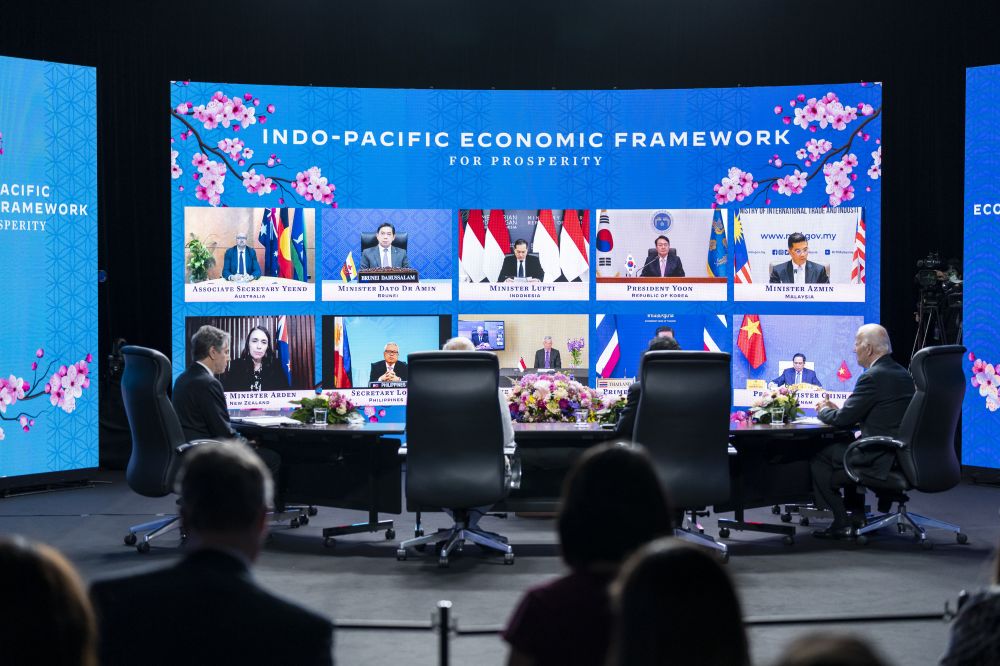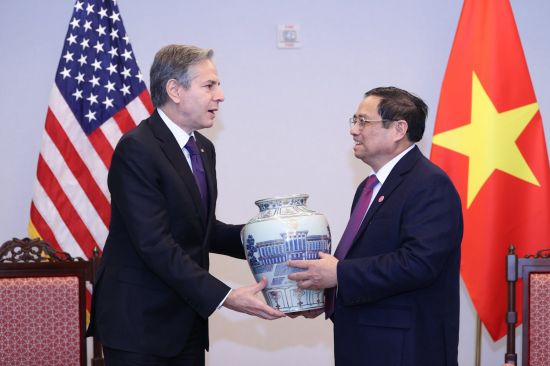The United States recently unveiled its long-awaited Indo-Pacific Economic Framework. James Borton of the School of Advanced International Studies at Johns Hopkins University writes that, while there was some disappointment that the initiative does not involve a binding trade arrangement or market-access commitments, ASEAN members, particularly key fast-growing economies such as Vietnam, may find the IPEF an attractive platform for advancing economic engagement with the US, while avoiding the crossfire of the Washington-Beijing strategic competition.
A new partnership blooms in Tokyo, May 23: US President Biden (seated, right) launches Washington's Indo-Pacific Economic Framework for Prosperity (Credit: The White House)
The administration of US President Joe Biden faces significant distractions from the war in Ukraine, record inflation, high gas prices, Covid-19, a shortage of baby formula, and uncontrolled gun violence. Through it all, the White House has pledged to maintain its Asia focus with the newly-launched, much anticipated Indo-Pacific Economic Framework for Prosperity (IPEF), which offers an open-ended or non-binding commitment whereby participating countries can choose to come together to bolster economic security.
The IPEF is neither a free trade agreement nor anything approaching a security bloc, unlike the Quadrilateral Security Dialogue, known as the Quad, which brings together Australia, Japan, India and the United States. At the launch on May 23 at a gathering of the Quad in Tokyo, 13 countries joined the IPEF: Australia, Brunei, India, Indonesia, Japan, the Republic of Korea, Malaysia, New Zealand, the Philippines, Singapore, Thailand, and Vietnam. Along with the US, that made a multilateral baker’s dozen – a powerful international mix accounting for 40 percent of global GDP. Pacific nation Fiji joined the IPEF three days later.
With no trade provisions or potential for reduced tariffs for commercial activities, however, it is difficult to begin to assess the impact of the vague framework. Yet, Washington’s messaging on the IPEF economic plan to tackle 21st-century challenges is clear: It is about setting rules of the road for the digital economy, ensuring resilient supply chains, paving the way for clean energy infrastructure investment, and raising standards for transparency, fair taxation and anti-corruption measures.
Although Southeast Asian countries share US concerns about Beijing, they remain cautious about siding more closely with Washington, given the region’s predominant economic ties with China and, for now, limited economic incentives from the US.
During the global health storm, the economies of the member states of the Association of Southeast Asian Nations (ASEAN) were especially hard hit, forcing them to make fundamental strategic changes to advance trade, attract investment, and stimulate economic growth. Naturally these critical measures have included strengthening their health systems and pressing for far more regional economic integration.
“It would be wrong to dismiss the IPEF as lacking substance,” says David Dapice, senior economist in the Vietnam and Myanmar Program at the at the Harvard Kennedy School Ash Center for Democratic Governance and Innovation. “It has narrow but real relevance in the areas it specifies. For example, if the US extended ‘green; loans for clean energy, it could help other nations avoid full impact of high fossil fuel prices and also aid them in meeting targets to lower carbon and other pollution.”
Covid-19 has spurred ASEAN members to adopt more advanced and rapid economic digitization. This is seriously needed to boost regional supply chains and overall business operations achieved through e-commerce and digital custom clearances.
Although details of the IPEF have not been laid out and Hanoi therefore remains on the sidelines, Vietnam’s participation will inevitably boost its economic output. “It is one way for Vietnam to stay engaged with the US in the trade rule-making space,” Murray Hiebert, head of research at consulting firm Bower Group Asia, argues.
Vietnam, it should be noted, is part of the Comprehensive and Progressive Agreement for Trans-Pacific Partnership (CPTPP), the advanced free-trade arrangement that the US negotiated with 11 other economies, only to have Biden’s predecessor, Donald Trump, withdraw. It is also among the 15 signatories to the Regional Comprehensive Economic Partnership (RCEP), the free-trade arrangement with ASEAN members at the core that was driven in large part by Beijing. The CPTPP went into force in the ratifying countries (so far, all but two members, Chile and Malaysia, have ratified the deal) at the end of 2018, while RCEP took effect in 10 of its 15 participants at the beginning of 2022. As of the end of June, only ASEAN member states Indonesia, Myanmar and the Philippines had yet to ratify RCEP.
The prospects for a leap forward in renewable energy or green technologies add ballast to the Vietnam’s efforts to mitigate climate change. Data at the end of 2021 revealed that the country generated over 16.5 GW of solar and 11.8 GW of wind power. The government plans to bolster this by adding 12 GW of onshore and offshore wind by 2025. According to Energy Tracker Asia, Vietnam has one of the best wind resources in Southeast Asia, with an estimated potential of 311 GW.
The good news is that the acceptance of IPEF does not in any way obligate a nation, especially one as strategically important as Vietnam, to choose between the US and China. It is noteworthy that, following the US-ASEAN Summit in May, Washington agreed to a US$150 million infrastructure package, including US$60 million for maritime assistance, with Vietnam as one of the primary recipients.
As a bulwark against China’s incursions into the South China Sea, what Hanoi calls the East Sea, the US has already provided Vietnam’s Coast Guard with six 45-foot Metal Shark patrol boats, with ongoing discussion about additional equipment. The delivery of these vessels will be another important step in the expanding security cooperation between the US and Vietnam.
“Of course there’s some concern that Vietnam will not meet all the IPEF standards in some areas such as labor rights,” says Bich T Tran, an adjunct fellow in the Southeast Asia Program at the Center for Strategic International Studies (CSIS) in Washington. Hanoi’s reform efforts as they implement the CPTPP will better prepare the economy for IPEF participation. Vietnam’s National Assembly ratified the agreement in 2018.
Another attractive IPEF pillar is the focus on digital technologies that would benefit all Southeast Asia nations as they recover from the pandemic. Vietnam has shown itself to be a fast adopter, notably during the country’s management of Covid-19. For now, the country knows that new technologies are urgently needed to address the disruptions in global supply chains.
The vital importance of sustainable practices associated with cleaner production and to support a commitment to a circular economy were already in the planning pipeline before pandemic. The spread of the virus raised awareness within ASEAN of how interconnected economic growth is with health and human security.
Despite Covid-19 and supply chain challenges, Vietnam has garnered high investor confidence and this is reflected in over US$3.3 billion inflows from Southeast Asian countries. Countries that have invested in Vietnam are Thailand, Malaysia, Brunei, Cambodia, the Philippines and Indonesia with processing and manufacturing industries leading the way. With IPEF, RCEP, CPTPP and of course the ASEAN Economic Community (AEC), expect significant growth in intra-ASEAN trade and investment, with Vietnam and the three other Southeast Asian economies that belong to all four arrangements (Brunei, Malaysia and Singapore) likely to be among the main beneficiaries.
For now, Asia’s cautious wait-and-see stance on the IPEF is understandable. The prevailing media narrative has been that the framework did not deliver the serious market-opening commitments ASEAN member economies hoped for. Yet, in Washington, there is optimism, however curious, about the successful adoption of this broader trade agenda that prioritizes sustainability and digital transparency.
Further reading:
James Borton
Foreign Policy Institute, School of Advanced International Studies (SAIS), Johns Hopkins University
Check out here for more research and analysis from Asian perspectives.



